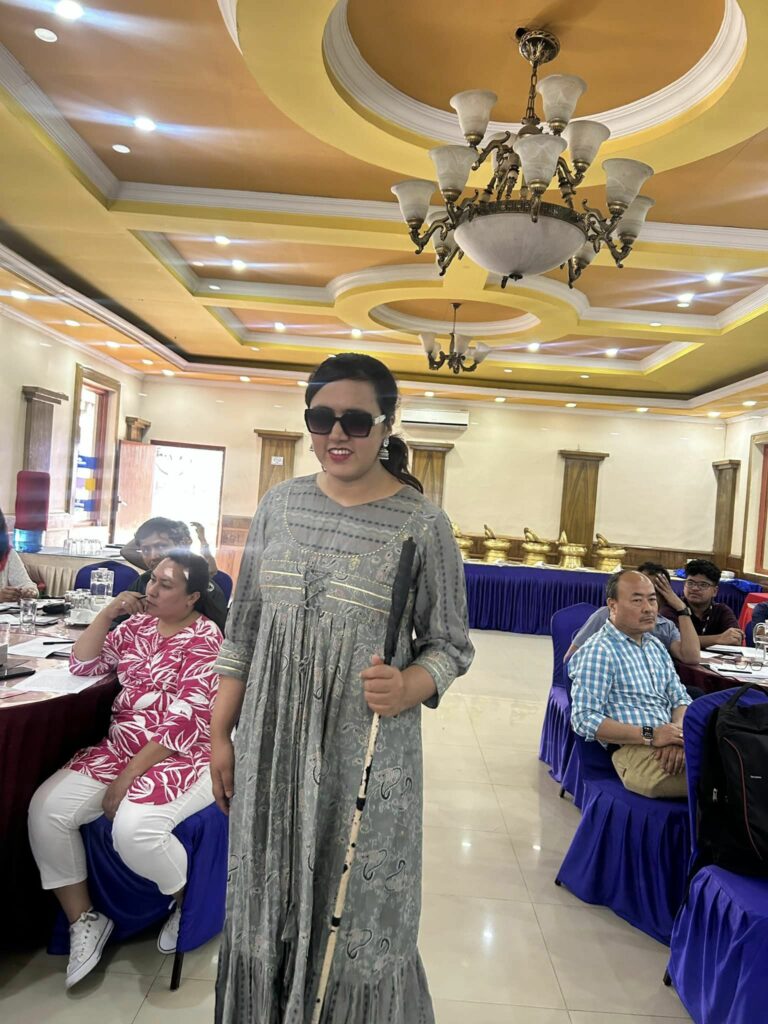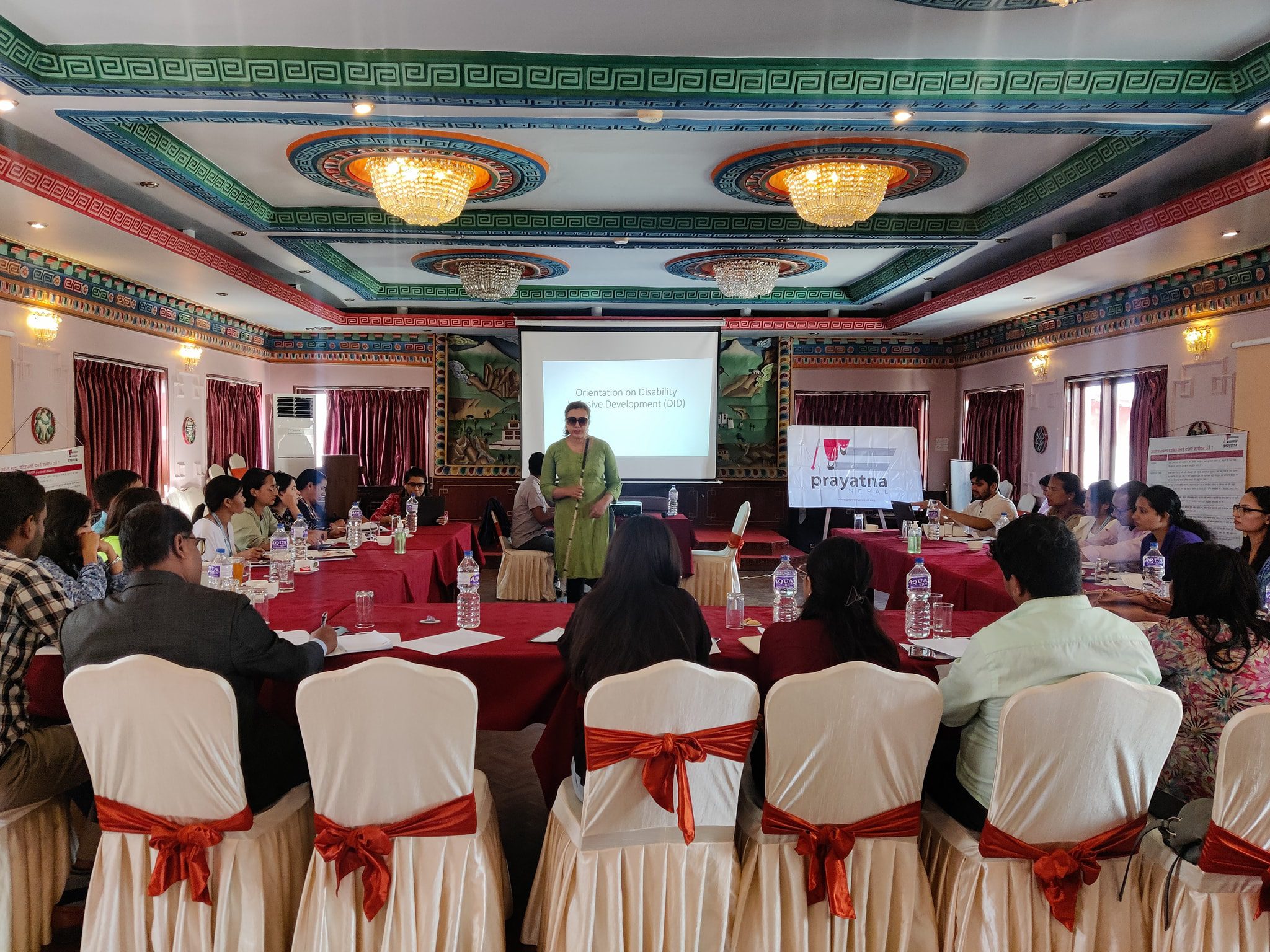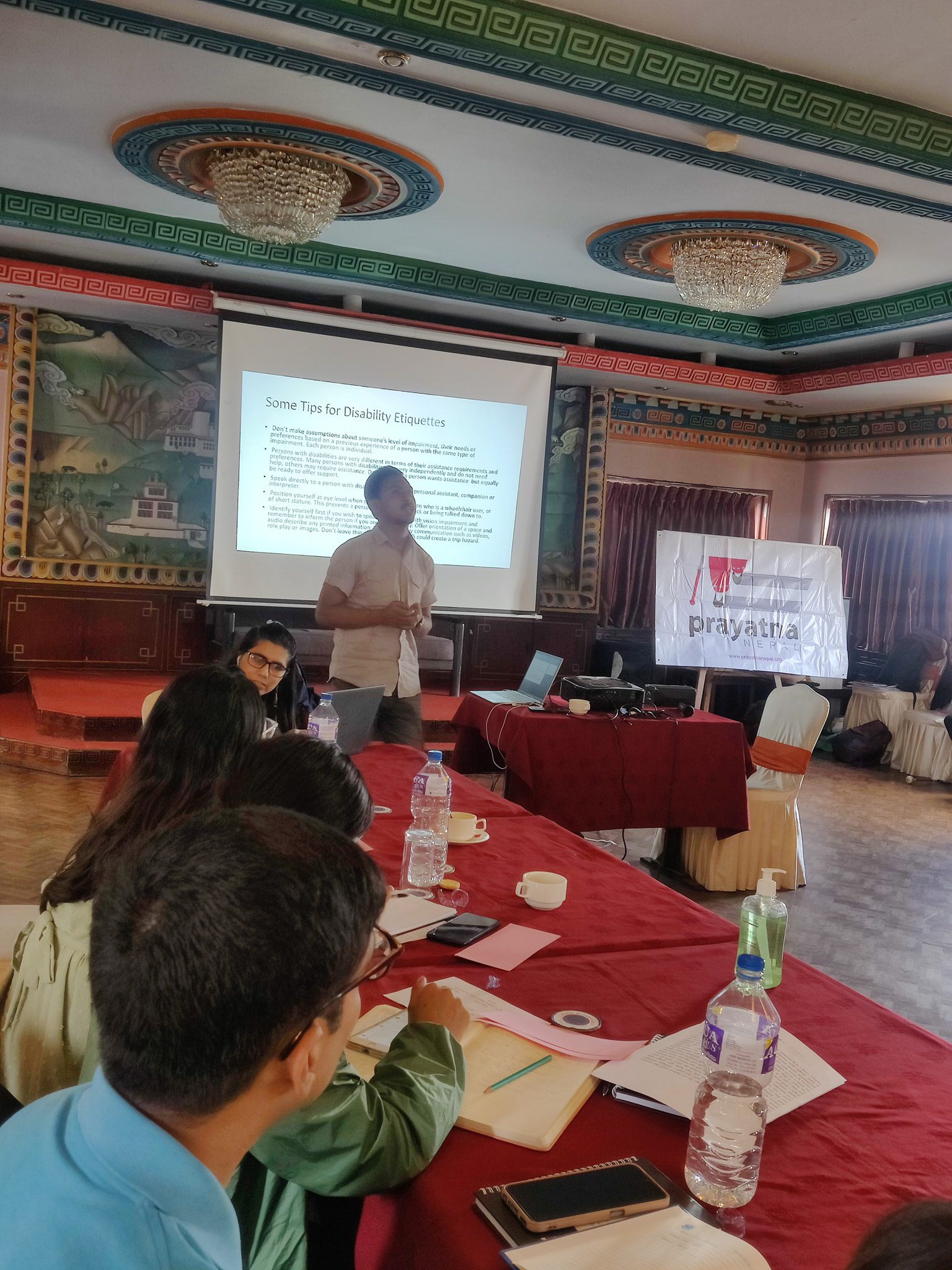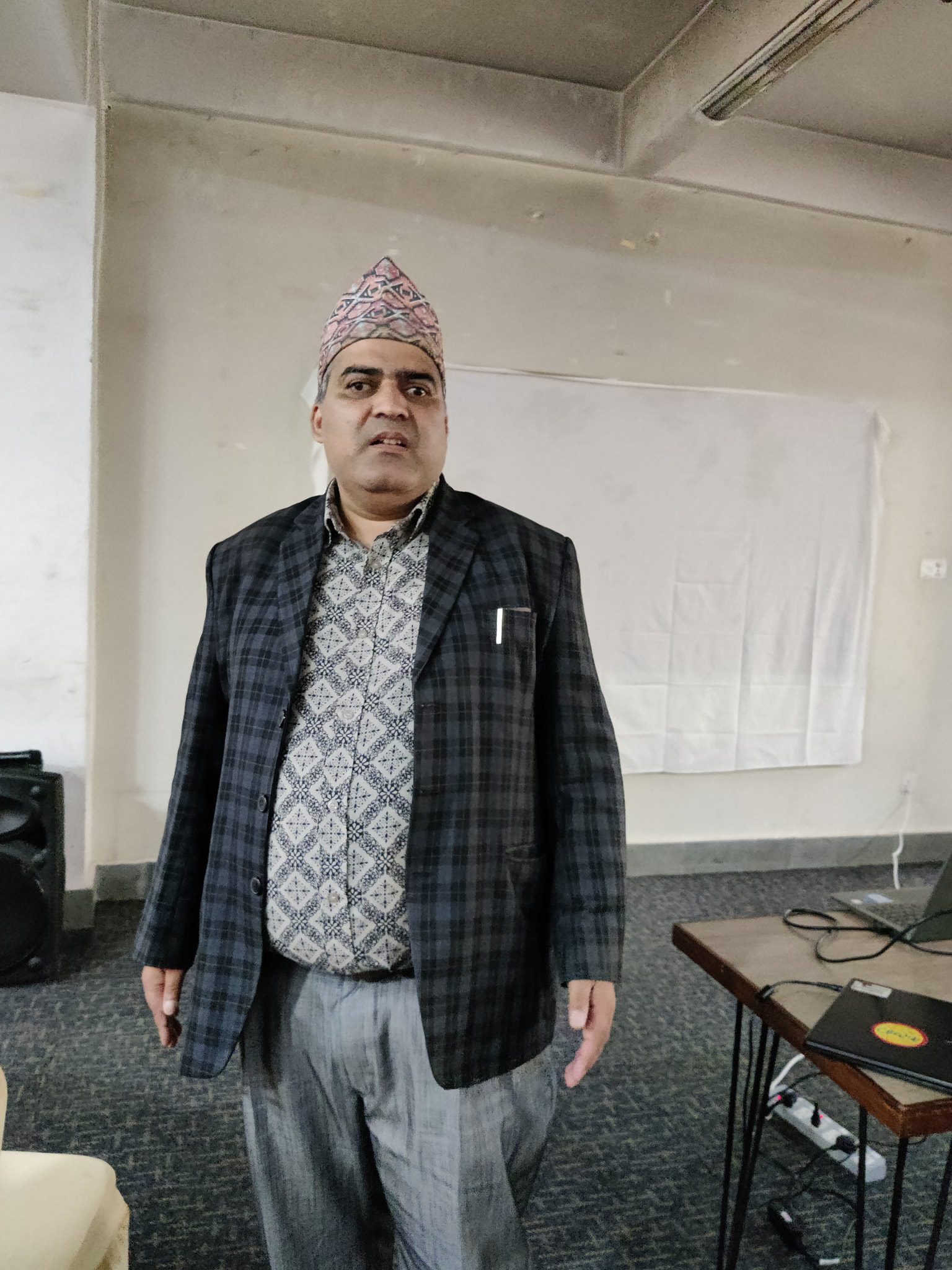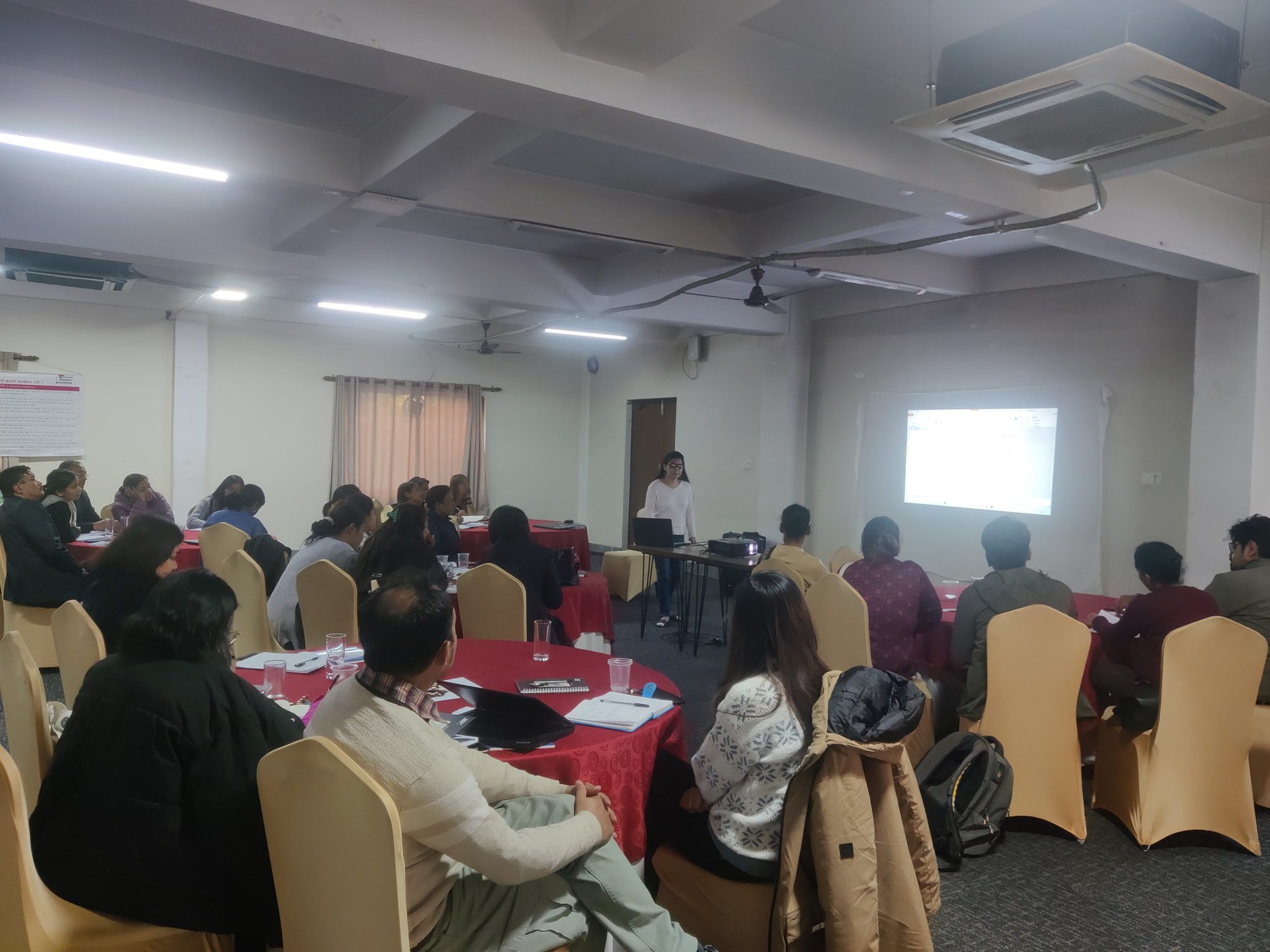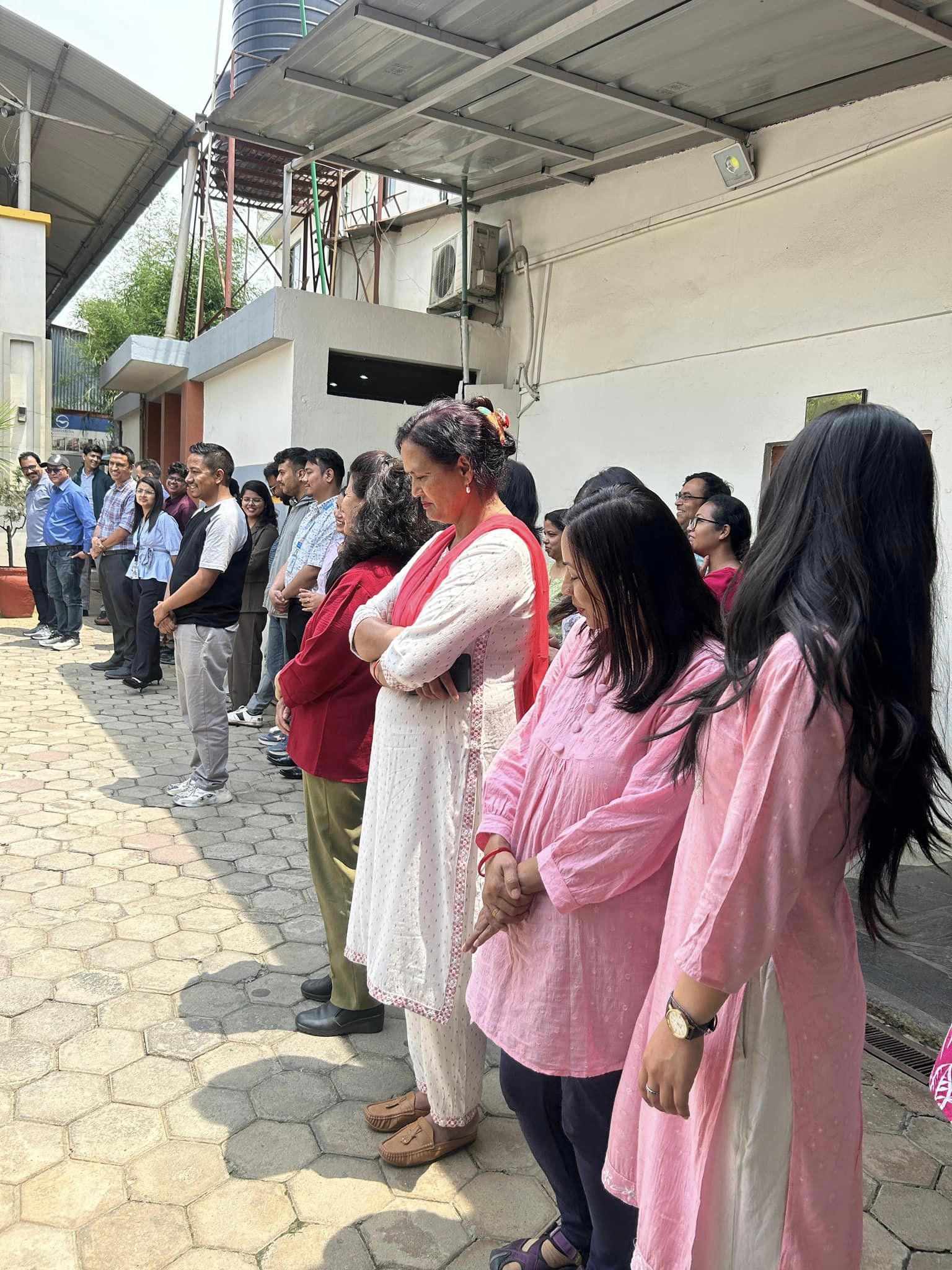The concept of disability has evolved significantly over the years, challenging societal perceptions and prompting the realization of the importance of inclusion and accessibility for all individuals. In an effort to address this crucial aspect, Prayatna Nepal, a pioneering organization dedicated to advocating disability rights and inclusive development, organized a transformative event titled "Disability Inclusive Development."
The event, held brought together stakeholders and representatives from various organizations committed to promoting disability inclusivity. With a focus on understanding the different dimensions of disability, the event sought to explore effective strategies for fostering a more inclusive society.
Objectives:
- Raising Awareness: The first objective of the event was to raise awareness about the concept of disability and its diverse manifestations. By shedding light on the various types and categories of disabilities, the event aimed to challenge stereotypes and promote a broader understanding of the challenges faced by individuals with disabilities.
- Identifying Gaps and Pathways: The second objective was to conduct an in-depth analysis of the existing gaps in disability inclusion across different sectors. Participants engaged in discussions centered around the ACAP model - Attitude, Communication, Access, and Participation - to recognize the barriers hindering inclusive development. Through this analysis, the event aimed to identify pathways and strategies to move from traditional community-based rehabilitation to community-based inclusive development.
First Session: Understanding the Evolution of the Concept of Disability
Facilitator: Sarita Lamichhane
In the first session, participants engaged in a discussion to comprehend the historical and evolving concept of disability. The voting process was utilized to explore different perspectives presented in the election manifestos of four distinct parties. Each party's focus on disability was examined, leading to insightful conclusions on the most inclusive approach.
Summary of Discussion:
The four parties' manifestos were analyzed, highlighting their respective approaches towards disability:
- The First Party: Emphasized the "Charity Model," which historically viewed disability as a cause deserving of sympathy and assistance.
- The Second Party: Advocated the "Medical Model," where disability was perceived as an individual's medical condition, often emphasizing medical treatment and rehabilitation.
- The Third Party: Supported the "Social Model," which stressed the importance of society's role in facilitating the participation and inclusion of individuals with disabilities.
- The Fourth Party: Focused on the "Rights-Based Model," recognizing disability as a matter of human rights and emphasizing the need for inclusion and equal opportunities.
Voting Results:
Following the discussions and analysis of the party manifestos, a majority of participants voted in favor of the "Inclusive Party" and the "People's Voice Party." These two parties received support due to their commitment to holistic inclusion of persons with disabilities, both during the planning phase and through practical measures for genuine inclusion in society.
On the other hand, the "Ramite Party" and the "Social Service Party" did not receive votes, as participants identified their negative outlook on disability. These parties were observed to view persons with disabilities as not entitled to basic education, employment, and other essential services in society. Additionally, they focused on charity-based approaches and social rehabilitation, perpetuating the perception of persons with disabilities as burdens on their families and society.
Overall, the participants collectively emphasized a rights-based approach, recognizing the importance of human rights, inclusion, and positive development for persons with disabilities while casting their votes based on the four parties' manifestos.
This session successfully shed light on the historical context and evolving understanding of disability, fostering a greater awareness of the various approaches and their implications for individuals with disabilities in society. The thoughtful deliberations and informed voting process have set the stage for deeper discussions in subsequent sessions to work towards a more inclusive and equitable future for all.
Second Session: Definition and Types of Disabilities
Facilitator: Nir Shrestha
Discussion: Participants' Views:
During the second session, participants expressed their views on the state of disability inclusion in Nepal's policies. They highlighted that the country still predominantly follows a medical model of disability, which is primarily focused on developed cities. The holistic human rights approach, encompassing medical, social welfare, and human rights perspectives, remains lacking in practical implementation.
Understanding Disability:
The session emphasized three essential conditions to consider when defining disability: long-term impairment, functional impairment, and participation restriction.
Types of Disability:
The participants acknowledged that Nepal's laws identify ten types of disability, but they admitted to having limited knowledge about each type. Several specific types of disabilities were discussed:
- Physical disability: Involving mobility impairments.
- Visual impairment: Partial or complete loss of vision.
- Hearing impairment: Partial or complete loss of hearing.
- Deaf-blindness: Dual sensory impairment of hearing and vision.
- Hemophilia: A condition affecting the blood's ability to clot.
- Psycho-social disability: Related to mental health conditions.
- Autism: A developmental disorder affecting communication and social interaction.
- Multiple disabilities: When a person experiences a combination of various disabilities.
Concluding Point:
Facilitator identified gaps in the categorization of disabilities in the country. Initially, there were four types, then seven, and currently, ten types of disabilities are recognized. The session urged for more comprehensive descriptions of each type of disability, particularly focusing on physical, visual, hearing, deaf-blind, hemophilia, psycho-social, autism, and multiple disabilities.
Category of Disability on the Basis of Severity:
The government of Nepal has introduced different disability cards based on the severity of the condition:
- Profound Disability: Identified by a red disability card.
- Severe Disability: Recognized with a blue disability card.
- Moderate Disability: Allocated a yellow disability card.
- Mild Disability: Assigned a white disability card.
Disability Inclusive Etiquette and Communication:
The facilitator provided participants with statements to help them understand the appropriate terminologies and behavior when interacting with people with disabilities.
Discussion Points: Statements and Clarifications:
- When interacting with individuals with disabilities, it is essential to ask about their preferred terminologies for addressing their specific condition, as they have firsthand experience and understanding.
- Communication with people with disabilities should avoid excessive sympathy and focus on simple language appropriate for their age, while being disability-sensitive.
- Do not hesitate to offer assistance or ask questions of a person with a disability; honesty and genuineness are vital in these interactions.
- Explaining things simply and avoiding complexity is particularly crucial when communicating with individuals with autism to ensure clarity.
- Create an environment where individuals with disabilities can make their own decisions without imposing preconceived notions or limitations on them; freedom should be encouraged.
- Use people-first language when addressing disabilities, emphasizing the person's identity first and then acknowledging their disability.
- In formal, official, and legal documents, avoid using the term "PWDS" (Persons with Disabilities) and instead use "person with a disability" directly.
- While communicating with individuals with physical disabilities, maintain appropriate eye contact to establish a smooth flow of communication.
- Different people have different needs and requirements, so individual considerations are essential.
- When guiding visually impaired individuals, offer your arm for clear positioning and appropriate support.
- Always ask before offering help to a person with a disability; respect their autonomy.
- Be careful not to reinforce discrimination or stigma while communicating with people with disabilities; avoid personal remarks, casual remarks, and over-generalizations.
- When communicating with a person with speech impairment, do not pretend to understand; instead, encourage clear and simple communication.
- Speak clearly and use straightforward sentences when communicating with individuals with learning disabilities.
This session provided valuable insights into the definition and types of disabilities, the need for improved policies, and the importance of disability-inclusive etiquette and communication. Participants recognized the existing challenges and emphasized the importance of a human rights approach to enhance disability inclusion in Nepal's society.
Third Session: Inclusive Organizational Development
Facilitator: Sarita Lamichhane
The third session focused on "Inclusive Organizational Development," led by the facilitator, Sarita Lamichhane. Given the diverse backgrounds of the participants, the session began with a series of thought-provoking statements related to how organizations are integrating disability-inclusive development in their operations.
The facilitator presented the following statements:
- Does your organization employ individuals with disabilities?
- Are there persons with disabilities represented in executive decision-making roles within your organization?
- Is your organization equipped with accessible physical infrastructure?
- Does your organization have websites that are accessible for people with disabilities?
- Does your organization disseminate materials that are easy to read, understand, and accessible to persons with disabilities?
- Does your organization provide sign language interpreters or volunteers for persons with disabilities?
Upon analyzing the responses, it became apparent that there were significant gaps in meeting the prerequisites for disability-inclusive development within organizational settings.
The Concept of Disability-Inclusive Development was discussed, emphasizing its importance and the objectives of minimizing barriers. The guiding principles for Disability-Inclusive Development were outlined as follows:
- Awareness
- Meaningful participation - persons with disabilities are not merely receivers but also contributors.
- Non-discrimination
- Accessibility and universal design
- Gender equity
- Twin-track approach
The session then shifted to compare the transition from Community-Based Rehabilitation (CBR) to Community-Based Inclusive Development (CBID):
Community-Based Rehabilitation (CBR) is a medical model-driven approach that focuses on dimensions like health and education.
Principles of CBR include:
- Inclusion
- Active participation
- Empowerment
- Collaboration and cooperation
CBR components include:
- Health
- Inclusive education
- Livelihood
- Social inclusion
- Dignity, respect, and utilization of local resources
On the other hand, Community-Based Inclusive Development (CBID) follows a developmental model that centers on disability-inclusive development.
Principles of CBID are:
- Disability-inclusive development
- Creative inclusive policy
- Accessibility
In summary, the session shed light on the significance of Disability-Inclusive Development in organizational settings, striving to bridge the gaps in meeting the necessary criteria. Participants were enlightened about the transition from the medical model-oriented Community-Based Rehabilitation (CBR) to the developmental model of Community-Based Inclusive Development (CBID). The aim of the session was to encourage organizations to embrace and implement more inclusive practices, fostering an environment where individuals with disabilities can participate fully and contribute effectively.
Fourth Session: Analysing Gaps in Disability Inclusion
Facilitator: Nir Shrestha
ACAP Model: Attitude, Communication, Access, Participation
Discussion:
During this session, participants engaged in identifying barriers within the ACAP model to uncover gaps and propose solutions for disability-inclusive development.
Barriers in Attitude:
- Lack of Individualism: Treating people with disabilities as a homogenous group, ignoring their unique needs and abilities.
- Lack of Capabilities Over Sympathy: Focusing on what individuals with disabilities cannot do rather than their strengths and potential contributions.
- Stereotype Stigma: Preconceived notions and negative beliefs about people with disabilities, leading to discrimination.
- Lack of Inclusion of Persons with Disabilities in Organizational Diversity Initiatives: Overlooking the representation and active involvement of people with disabilities in diversity efforts.
Barriers in Communication:
- Unavailability of Multiple Study Materials: Insufficient accessible materials that cater to different learning needs of individuals with disabilities.
- Use of Non-Verbal Gestures: Relying heavily on non-verbal cues in communication, which can hinder understanding for those with sensory disabilities.
- Hesitancy in Communicating with Persons with Disabilities: Uncertainty or discomfort when engaging in conversations with individuals with disabilities, leading to avoidance.
Barriers in Access:
- Lack of Physical Infrastructure: Inadequate accommodations in buildings and public spaces, making accessibility challenging for people with disabilities.
- Insufficient Healthcare Access: Limited availability of healthcare services tailored to the needs of people with disabilities.
- Non-Disability Friendly Public Transportation: Public transport systems not designed to accommodate those with mobility challenges.
- Absence of Disability Sensitivity Training: Lack of awareness and training among service providers on catering to the needs of people with disabilities.
Barriers in Participation:
- Digital and Physical Barriers: Participation barriers stemming from inaccessible online platforms and physical spaces.
- Limited Opportunities to Express Opinions: People with disabilities may not be given equal opportunities to share their perspectives and ideas.
- Lack of Pragmatic Policies in Organizations: Absence of practical policies supporting disability inclusion in HR and administrative processes.
- Lack of Awareness Gap: Disconnect between the non-disabled and disability communities, hindering effective collaboration for development.
- Importance of Inclusive Development Mechanisms: Failure to prioritize disability-inclusive practices in developmental initiatives.
- Lack of Disability Representation: Underrepresentation of people with disabilities in decision-making processes.
- Mindset Challenges: Attitudinal barriers from both non-disabled individuals and those with disabilities, impacting progress.
- Lack of Motivation for Initiating Change: Reluctance or resistance to drive change and prioritize disability inclusion.
- Underutilization of Budget and Quality Monitoring Statistics: Inadequate allocation and tracking of resources dedicated to disability inclusion.
- Influence of Nepotism Culture: Favoritism and bias affecting opportunities for people with disabilities.
Way Forward:
The session concluded with the recommendations from facilitator to promote disability inclusion in mainstream programs. The following actions were proposed:
- Promote Awareness and Sensitization: Conduct workshops and training sessions to raise awareness and sensitize individuals about disability-related issues and challenges.
- Develop Inclusive Policies: Implement pragmatic policies that actively promote the inclusion of people with disabilities across various organizational functions.
- Enhance Communication Strategies: Foster clear and accessible communication techniques to engage effectively with individuals with disabilities.
- Improve Accessibility: Invest in creating and maintaining physically accessible infrastructure, including transportation and public facilities.
- Encourage Participation: Ensure active and meaningful involvement of people with disabilities in decision-making processes and development initiatives.
- Embrace Diversity and Representation: Prioritize diverse representation, including individuals with disabilities, in leadership and policy-making roles.
- Monitor and Evaluate: Establish a robust monitoring and evaluation system to track progress and measure the impact of disability-inclusive measures.
- Advocate for Change: Collaborate with advocacy groups and stakeholders to push for legislative changes that support disability rights and inclusion.
- Allocate Sufficient Resources: Dedicate adequate resources and funding to implement and sustain disability-inclusive programs effectively.
Key Takeaways from the "Disability Inclusive Development" Event:
- Evolving Perspectives on Disability: The event highlighted the historical evolution of disability concepts from the "Charity Model" to the "Rights-Based Model." Participants learned that shifting towards a rights-based approach is crucial for recognizing disability as a matter of human rights and promoting inclusion and equal opportunities for individuals with disabilities.
- Importance of Awareness and Understanding: Raising awareness about the diverse manifestations of disabilities is essential to challenge stereotypes and promote a broader understanding of the challenges faced by people with disabilities. The participants emphasized the need to educate society about the different types and categories of disabilities to foster empathy and inclusive attitudes.
- Barriers to Inclusion: The ACAP model (Attitude, Communication, Access, Participation) provided valuable insights into the various barriers hindering disability-inclusive development. Participants identified attitude-related challenges, communication barriers, lack of accessibility, and limited participation opportunities as key obstacles that need to be addressed for meaningful inclusion.
- Transition to Community-Based Inclusive Development (CBID): The session on inclusive organizational development shed light on the transition from Community-Based Rehabilitation (CBR) to Community-Based Inclusive Development (CBID). Participants recognized the importance of moving from a medical model-driven approach to a developmental model that centers on disability-inclusive development and encourages active participation and empowerment of individuals with disabilities.
- Disability-Inclusive Etiquette and Communication: Understanding appropriate language and behavior when interacting with people with disabilities is crucial for fostering inclusive environments. Participants learned about people-first language, the importance of clear and accessible communication, and the significance of respecting the autonomy and preferences of individuals with disabilities.
- Recommendations for Disability Inclusion: The event concluded with actionable recommendations to promote disability inclusion in mainstream programs. Participants acknowledged the need for awareness and sensitization, inclusive policies, improved accessibility, enhanced communication strategies, and the active participation of individuals with disabilities in decision-making processes. Additionally, monitoring and evaluation systems, advocacy for legislative changes, diverse representation, and sufficient resource allocation were highlighted as essential elements for successful disability-inclusive development.
Conclusion:
The "Disability Inclusive Development" event organized by Prayatna Nepal on 17th July 2023 was a transformative platform that brought together stakeholders and representatives from various organizations committed to promoting disability inclusivity. The event successfully achieved its objectives of raising awareness about the concept of disability and its diverse manifestations, identifying gaps in disability inclusion, and exploring effective strategies for fostering a more inclusive society. Through thought-provoking discussions and the insightful ACAP model analysis, the event highlighted the evolution of disability concepts, emphasizing the importance of embracing a rights-based approach to promote inclusion and equal opportunities for individuals with disabilities. The sessions shed light on the significance of awareness and understanding, the barriers to inclusion in attitude, communication, access, and participation, and the need for a transition to Community-Based Inclusive Development (CBID). Overall, the "Disability Inclusive Development" event created a platform for meaningful dialogue, fostering a greater understanding of the challenges faced by individuals with disabilities and the steps required to build a more inclusive and equitable society. The insights gained and the proposed recommendations will undoubtedly contribute to the ongoing efforts in promoting disability rights and fostering an environment where every individual can participate fully and contribute to the betterment of society.
